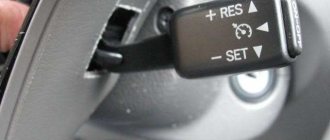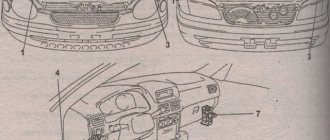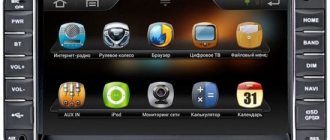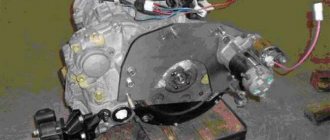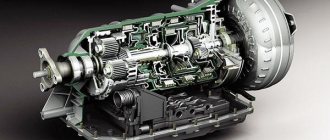A car, as you know, is a means of transportation, but not a luxury item. But the cost of some diagnostic and repair operations casts doubt on this. In many ways, this also applies to Japanese cars that are popular among us.
So knowing how Toyota’s self-diagnosis starts, for example, can save you a lot of money. There is nothing particularly difficult about this operation, you just need to be more careful and follow the instructions exactly. So how to do a self-diagnosis? Toyota is a fairly new car (assuming that yours is not a rarity), and therefore it has quite a lot of electronic circuits that greatly facilitate this task.
Basic information
In principle, any more or less modern car has a special engine self-diagnosis unit. How does this mechanism work? Quite simple: electronics constantly monitors the performance of devices, comparing them with the reference values set by the manufacturer. If something is wrong, a diagnostic program is activated, which specifically determines what exactly has gone wrong. Roughly speaking, this is how Toyota’s self-diagnosis works.
Only when all elements are in order will the bypass program be removed and the engine will begin to operate normally. Note that many are familiar with the illuminated inscription “CHECK” or a separate pictogram with an image of the engine, which indicate a malfunction. If the fault has been repaired, the image or icon goes out.
In general, this is self-diagnosis. Toyota in this regard is a very “friendly” car, since everything is immediately visible on the dashboard (in most cases), and the Japanese themselves took care of the availability of normal, detailed manuals and recommendations that describe all possible error codes, which makes life much easier for service workers and ordinary motorists.
Decoding combinations
Gasoline internal combustion engines
First, let's look at deciphering the combinations of self-diagnosis faults inherent to Toyota gasoline engines.
Diagnostic connector DLC1
| Combination | Decoding |
| 12, 14 | The control unit informs the car owner about the incorrect operation of the crankshaft position control sensor. |
| 14,15 | A breakdown of one of the four ignition coils has been reported. |
| 16 | Incorrect operation of the transmission has been registered. It is recommended to carry out a more thorough check of the gearbox. |
| 19 | Incorrect accelerator pedal position. It could also be a problem with the pedal position sensor. |
| 21 | The oxygen sensor has failed. For correct operation, it is recommended to replace the device. |
| 22 | The refrigerant temperature control device in the refrigeration system sends an incorrect signal to the BC. The sensor needs to be replaced. |
| 24 | The intake air temperature control sensor is broken. |
| 25 | The oxygen sensor sends an incorrect signal to the on-board computer. In particular, the BC recorded a signal that the mixture in the injection system was too lean. |
| 31 | The control unit reports incorrect operation of the absolute pressure control device in the internal combustion engine system. |
| 34 | Malfunctions in the functioning of the turbocharging system have been reported. |
| 36 | The CPS sensor has failed. |
| 41 | The on-board computer reports an incorrect signal coming from the throttle position control device. |
| 42 | The driver is notified of a breakdown of the vehicle speed sensor. |
| 43 | The on-board computer receives an incorrect signal from the starter. A thorough check of the mechanism should be carried out. |
| 49 | Incorrect operation of the fuel pressure monitoring device. It is necessary to replace the sensor and check again. |
| 52, 53, 55 | Incorrect operation of one of the knock sensors. The device should be replaced. |
| 92 | Incorrect operation of the cold start injector. The element must be replaced. |
| 98 | A breakdown of the vacuum control device in the vacuum brake booster was registered. |
Diesel internal combustion engines
Checking a car for errors using special diagnostic equipment
Next, let's look at the decoding of errors that arise when diagnosing Toyota cars with diesel engines.
| Combination | Decoding |
| 12 | A broken crankshaft sensor has been reported. |
| 13 | The control unit has detected a breakdown in the operation of the shaft speed control device. |
| 14 | A breakdown in the operation of the injection timing adjustment valve was detected. |
| 15 | Indicates that the throttle servo is not operating properly. |
| 17 | There are problems with the control unit. It is necessary to make a more accurate diagnosis of the block. |
| 18 | Problems have been detected in the operation of the electromagnetic bypass valve. The device should be replaced and diagnostics performed again. |
| 19 | The clutch pedal position control device does not work correctly. Replace the sensor. |
| 22 | The antifreeze temperature control mechanism in the cooling system has failed. |
| 24 | The intake air temperature sensor has failed. |
| 32 | The on-board computer registered a malfunction in the functioning of the correction resistors. |
| 35 | Malfunction of the boost pressure control device. Replace the sensor and re-diagnose the vehicle. |
| 39 | Incorrect operation of the fuel temperature sensor. |
| 42 | The vehicle speed sensor has stopped working. The device must be replaced. |
| 96 | There is a malfunction in the EGR valve position sensor. |
Automatic transmission
Diagnostic connector for checking the machine
| Combination | Decoding |
| 11 | This combination means that no malfunctions have been identified in the operation of the automatic transmission system. |
| 37 | A malfunction of the unit input shaft speed control device has been reported. |
| 38 | Indicates a failure of the transmission fluid temperature sensor. To prevent damage to the unit, you should replace the sensor, and then do the diagnostics again. |
| 42, 44 | There has been a malfunction in the output shaft speed sensor. It is recommended to replace the device for correct operation of the unit. |
| 46 | The hydraulic accumulator pressure control solenoid has failed. |
| 61 | There is a malfunction in the speed sensor. The device should be replaced. |
| 62, 63 | The first or second solenoid has failed. |
| 64 | The control unit informs the car owner about the incorrect operation of the torque converter lock-up clutch solenoid. |
| 73 | The on-board computer detected incorrect operation of the center differential lock clutch solenoid. |
Other codes
Scanner for checking a car for errors
Next, we will look at the error codes that appear when diagnosing a Toyota using special equipment. The list of errors is far from complete, but the most common malfunctions are considered.
| Combination | Decoding |
| c1201 | This combination indicates that the motor is not operating correctly. in practice, such an error occurs if the engine speed drops below 500. |
| p0171 | The combination indicates that the fuel mixture level in the engine is too lean. |
| p1604 | The car's on-board computer reports a breakdown of the intake system. A detailed check of the system should be carried out. |
| p1656 | An open or short circuit has been reported in the VVT system. Also, the on-board computer could record a breakdown in the operation of the VVT valve or electronic control unit. |
| b1801 | This code indicates an open circuit in the squib circuit on the driver's seat side. The wiring should be checked for shorts and breaks. |
| p1349 | Indicates incorrect operation of the VVT-i valve. The device must be replaced. |
| c1241 | The on-board computer reports that the pressure limit switch in the ABS unit is closed. The circuit should be checked for breaks and short circuits. |
| p0352 | Malfunctions were detected in the operation of the ignition system circuit. To ensure proper operation of the transport, check the circuit more accurately. |
| p0051 | The oxygen sensor heating device has failed. |
| b0101 | The control unit reports incorrect operation of the security system, in particular the airbags. |
How is this operation useful?
It is important to remember that data about an error that occurs must be entered into the memory of the on-board computer. If its power was not interrupted (the battery was not removed, for example), this data can be read from the instrument panel (Toyota) or pulled out from the computer itself (Nissan). In case of some malfunctions, the engine will immediately stall, but in some cases, when the malfunction prevents the operation of the machine, the error code is simply recorded in the internal memory of the computer.
This is very convenient, since later you will be able to find out all the details about the condition of your car. Actually, this is what self-diagnosis is good for. Toyota, therefore, compares favorably with other foreign cars in that you can save a lot on finding out the reasons why various problems occur.
In addition, this way you can find out the reasons why the car behaves abnormally from time to time. For example, you stopped due to a stalled engine in the middle of the road. We turned the key in the ignition a couple of times - the engine started up smoothly and the car drove on. What was it? You definitely won’t know anything by eye, but if you look at the contents of the on-board computer’s memory, everything will become clear. How does Toyota self-diagnosis start? Let's find out!
Work without errors: Toyota self-diagnosis
Toyota Motor Corporation was one of the first car manufacturers to install self-diagnosis systems on them. This innovation made it possible to record information about a malfunction in the memory of the on-board computer, after which it could be analyzed. The innovation turned out to be so useful that today all cars are equipped with these systems.
The first self-diagnosis systems began to be installed by Toyota Motor Corporation
The OBD-II standard has become uniform for all automakers, defining the type and pinout of the diagnostic connector, the communication protocol and the format of the transmitted data. Of the 16 pins of the standard DLC connector (Diagnostic Link Connector), only 4 (housing) and 16 (+12V from the battery) cannot change their purpose. Some contacts are not described by the standard and are intended for unique tests by manufacturers.
Start of diagnostics
Under the hood of the Toyota there is a special connector for diagnostics. It looks like a plastic box with DIAGNOSTIC written on it. You need to open its cover to see detailed markings of all pins on its reverse side. After this, take any suitable piece of wire, which closes the “TE1” and “E1” connectors. Get behind the wheel of the car, turn on the ignition (be sure to turn off the air conditioning and heater), and then carefully monitor the “CHECK” lamp.
So, immediately after turning on the ignition, it should start blinking. If the lamp blinks continuously two or more times, then the computer memory is empty. You remove the jumper, close the diagnostic unit and go about your business further.
Self-diagnosis using the example of Toyota Corolla
This model has been chosen as the best selling in the world. Depending on the year of manufacture, different types of connectors may be installed on the machine, which does not affect the diagnostic work. Extended error codes can only be read by a scanner, but the malfunction can be roughly determined without visiting a service center.
Depending on the type of installed connector, you need to close either contacts “TE1” and “E1” or 4 and 13. Then, by the nature of the blinking indicators, you can judge the location of the malfunction and its type. Fault tables should be used for each specific Toyota car model.
It is very important to use official publications, and not translations made in the gates. For almost any car, a high-quality description can be found among the books of the Legion-Avtodata publishing house, which specializes in publishing literature for car enthusiasts.
If reading with a scanner allows you to read universal 4-digit OBD2 codes, then simplified diagnostics will “blink” their 2-digit counterparts.
Worth knowing
Modern diagnostic units divide faults into two types: light and heavy, and in the first case they do not clog the memory of the on-board computer with error codes. So, if a simple malfunction disappears for some reason, then no records will remain about it. It often happens that after driving on a bad, dirty road, “Jackie Chan” begins to signal a malfunction of the ABS system. The on-board computer will immediately turn it off. But as soon as you wash the car properly after such a trip, the contacts will be cleaned and everything will return to normal without any repairs.
On which model does self-diagnosis most often end this way? "Toyota Corolla" of some series is the most striking example; such cars are completely unsuitable for driving on domestic roads.
Why is Toyota self-diagnosis so important?
A modern car contains a huge amount of electronics that control all its systems. Every time you start the engine, a full diagnostic cycle is carried out, which eliminates the possibility of starting the engine with faulty systems. The diagnostic result is indicated by the blinking of the corresponding control indicators, which makes it possible to judge the location of the malfunction.
All errors recorded during diagnostic operations, both those that occur during startup and those that occur during movement, are recorded in the computer memory. When reading with special scanners, it becomes possible to much more accurately determine the cause of the malfunction and localize the location of its occurrence. The information is stored permanently in the on-board computer and can be deleted by a special command or during a long power outage (more than 40 minutes).
Toyota self-diagnosis video tip
Some error codes
Here's an example: a flash/pause, then a flash again, followed by a long pause and a regular flash, indicates error #21. Another example: if after blinking there is a long pause, then blinking again and a pause, followed by a flash again, then this is error No. 12. Note that each Toyota engine has its own table of error codes. But here it should be remembered that most motors in this regard are practically no different from each other, since many models simply do not provide some signals.
In addition, in most cases they have different test standards: on one model the device can produce 0.45 volts, and on another – 0.5. We say all this so that you clearly understand: there are no fundamental differences in launching diagnostics, only the codes and reference values programmed at the factory differ.
The simplest table of fault codes is observed on old cars of the Japanese company. If the car is working properly, then it simply blinks the light, and the interval between flashes is three seconds. All faults are identified by only ten codes, so in this case self-diagnosis is extremely easy. The Toyota Corolla of the first families has just such a simplified system.
Important Note
It is important to remember one simple rule: all engines of the Japanese concern are initially equipped with almost identical diagnostic programs. However, due to design differences that can occur even within the same family of the same Corolla, the signals will be completely different.
It is completely pointless to present them on the pages of this article, since this data should be in the operating manual of your machine itself. We strongly do not recommend using data from other models, since with this approach you may completely incorrectly diagnose the problem that has arisen in your car.
Differences in diagnostic blocks
On old Toyota cars there is no diagnostic unit, but there is a freely dangling “chip” with two contacts, protected by a plastic cap. Actually, its outputs are similar to the “E1” and “TE1” connectors of new machines. If there is nothing at all, then you can take a 12V lamp and two wires: one of them is grounded against the case, and with the second you should touch all “suspicious” connectors. Don't worry, you won't burn anything.
When you do find “TE1”, the lamp on the dashboard will immediately go out, and the on-board computer will begin to issue a fault code. Please note that when connecting the “E1” and “TE1” pins, not only the EFI diagnostics will be launched, but also a check of some third-party units.
Clearing memory from previous readings
As a rule, to do this, you need to pull out the HAZ-HORN fuse, and in other models - STOP (see your vehicle's owner's manual). Sometimes there is an EFI option. However, everything can be done simpler: disconnect the negative terminal of the battery for half a minute, after which the memory will be reset to zero with a guarantee. But this will also erase the memory in the air conditioner and clock. And also, if your car is 1998 or newer, such a harsh cleaning can cause problems with the operation of many systems, and all this can last up to several days.
This is explained simply: modern cars can adapt to a specific driving style, and the data is also stored in the memory of the on-board computer. However, this phenomenon also has a purely positive side. Many of us buy a car after one or two owners, and their driving technique was not always satisfactory. Such a car can consume a lot of gasoline and react inadequately to the gas pedal. In a word, she behaves badly and is clearly “asking” for a trip to the service center.
But before that, you may well try to reset your memory. As practice shows, this is often quite sufficient. In this case, you will not only save your money, but also gain important experience. But how to do a self-diagnosis? Toyota, as we have already said, does not present any special surprises in this regard, so nothing particularly difficult awaits you.
General procedure for diagnosing ABS and TRC
This is done in the following order:
- Turn on the ignition without starting the car engine. If there are differential locks, they need to be disabled, otherwise the self-diagnosis of the Toyota engine simply will not start due to software restrictions.
- Find the DLC 1 diagnostic unit (as we said, it is located under the hood), then, according to the “recipe” given above, insert a wire or wire jumper there. Note that the MR-2 model does not have the connectors we require in DLC 1. In this case, look for a dangling “medallion” with connectors that will hang near the engine. The body should say ABS.
- The ABS lamp will begin to blink, using its signals to determine a specific malfunction.
- After this, you can clear the computer's memory. You need to turn on the ignition, turn off the differential locks (if any), and then quickly press the brake pedal, and the interval between presses should not exceed three seconds. When the memory is completely cleared, the diagnostic lamp will begin to blink at intervals of 0.5 seconds between blinks.
In general, this is how Toyota ABS self-diagnosis is performed. The jumper with DLC 1 is removed, after which the standard part is installed in place. And in the case of ABS, the block is returned to its original state.
Box diagnostics
All of the above related mainly to taking readings from the engine. But what about self-diagnosis of Toyota automatic transmission? In general, there are no special differences (except for error codes, of course):
- Turn on the ignition, but do not start the car. In this case, the automatic transmission lamp should light up immediately and go out after three seconds. If this is not observed, then you will have to carefully check all the fuses, as well as the physical integrity of the lamp itself and the wires.
- Turn off the ignition. On the same DLC 1 connector, you need to connect the more than once mentioned “E1” and “TC” pins. Apply the handbrake, and immediately after that start the engine. Now the automatic transmission indicator should blink four times per second.
- Start moving in a straight line: you have to accelerate to at least 80 km/h. If the indicator continues to flicker at the same frequency, then everything is fine with the speed sensors. Otherwise, the check will have to be continued.
- Stop the car. After this, you need to remove the jumper between “TS” and “E1” and install it between “E1” and “TS”. Reading the codes. If there are more than two codes, then there will be an interval of 2.5 seconds between them.
- Clear the memory again using the method described above.
This is how self-diagnosis of a Toyota automatic transmission is performed. In some car models, it can be difficult to find the EFI unit. Typically, it is located under the front passenger seat or on the left pillar of the body. In its metal case there is a clearly visible hole through which you can easily see two LEDs: red and green, with the help of which error codes are displayed. In this case, the red LED produces tens of units, and the green LED – units.
In addition, there is also a connector for a screwdriver, with which you can select the test mode. Before starting the test, you need to make sure that this knob is turned clockwise all the way.
How to do a Toyota self-diagnosis?
In order to start engine self-diagnosis, you need to close the “TE1” and “E1” contacts in the DLC1, DLC2 connectors in the diagnostic connector with a paper clip, and if self-diagnosis is carried out using the DLC3 connector, then close the “TC” and “CG” contacts.
The location of the contacts, by the way, is usually located under the protective cover of the connector. After this, turn on the ignition and observe the warning lamp. If there are no faults, the lamp blinks constantly at a frequency of a quarter of a second. If there are problems, the blinking of the lamp displays the fault code in digital form. First of all, the number of tens is displayed by long moments of lamp burning, after (after 1.5 seconds) units are displayed by more frequent blinking of the lamp. For example, three long and two short lamp beeps indicate code “32”. If there is more than one fault in the memory, then the next code is displayed after an interval of about 2.5 seconds. All codes are repeated in a cyclic circle, the pause between rows of codes in a circle is 4.5 seconds.
You can decipher the code using the table of fault codes for your car. This table is very often published in service books for repairing a specific car. In addition, the World Wide Web contains special sites with databases of fault codes for most modern cars and their decoding; application stores of modern smartphones, by the way, can also contain programs of this kind, which is very convenient.
In the same way, you can diagnose other systems:
To do this, you need to close or open the necessary connectors in the diagnostic block. Which connectors need to be closed to diagnose the corresponding mode in brief:
- The automatic transmission is read by the “O/D OFF” lamp (connector DLC1: “TE” – “E1”; connector DLC3: “TC” – “E1”);
- SRS by the corresponding “SRS” warning lamp, sometimes it is found in the form of a pictogram of a deployed airbag (connector DLC1: “TE” – “E1”; connector DLC3: “TC” – “E1”);
- 4WS system also by the corresponding indicator (DLC1 connector: “TC” - “E1”);
- ABS system (the connectors in DLC1 are closed: “TC” – “E1”, and the jumper from “WA” – “WB” is removed; after reading is completed, the jumper must be returned to its place).
In conclusion, I would like to note that the Toyota self-diagnosis system is the first direction of movement towards a malfunction. And we cannot immediately talk about a specific failure of any sensor, because a simple interruption in the power supply to the circuit or its contamination is possible. So, having decided on the direction, it is necessary to test a specific node for performance.
Other diagnostic schemes
There are two more schemes used on some car models of this company (in particular, this characterizes the self-diagnosis of the Toyota Mark 2). As a rule, they are used on early production machines. This operation should be carried out in this order:
- Turn on the ignition. After this, make sure that both diodes light up: if this does not happen, you will have to look for broken wires or other faults.
- Using a screwdriver, move the handle to the right until it stops.
- The following codes should be displayed in order: 23, 24 and 31. However, other errors may appear. If this happens, we advise you to write them down.
As we have already said, the red LED is a ten, the green LED is a one.
For example, “23” will look like this: first the green light will blink twice, and then the red light will blink three times. Important! If the machine is working properly, then after the three above codes appear there will be a long pause, and then the same signals again. And this will continue indefinitely. In particular, this characterizes the Toyota Carina, the self-diagnosis of which, due to such cyclicality, is perceived inadequately by some mechanics, since they see errors in repeating signals. If everything is OK, press and release the accelerator pedal. Signals 24 and 31 should remain. If any Toyota self-diagnosis errors appear, you need to write them down. After that, start the car. Only signal 31 may remain, but 24 and 31 flash more often (in particular, this is how the Toyota Camry self-diagnosis is performed). As in the previous case, write down additional codes (if they appear).
Turn the air conditioning system on and off again. After this, signals 44 and 24 (or one 44) should appear. Write down other commands (if any) and turn off the engine. After that, erase your memory. To do this, you need to turn off the ignition and turn the knob with a screwdriver one by one to each extreme position (starting from the left, of course), holding it in each case for at least two seconds. Remember that removing the battery does not always help, since some old units can “keep” the readings throughout the day.
How to do self-diagnosis correctly
Self-diagnosis eliminates the possibility of starting an engine with faulty systems
The key to correct diagnosis is compliance with the following conditions:
- The battery voltage should not be lower than 11V.
- The engine must be preheated to normal operating temperature.
- Speed selector in neutral position.
- All additional equipment is disabled.
After checking that these conditions are met, we close the required terminals of the diagnostic connector, and then turn on the ignition. If the terminals are closed after turning on the ignition, the test mode will not be activated.
As a rule, in Toyotas produced before 1998, it is required to close contacts “TE1” and “E1” in the engine compartment, and in the rest (4 and 13) - in the passenger compartment. The most modern models exchange data only using the OBD2 protocol, and they do not provide for reading data by blinking indicators.
It is important to note that the malfunction of various components is indicated by separate indicators. Before performing self-diagnosis, carefully study the documentation for your car.
It is much easier to accurately diagnose all systems, including automatic transmission, ABS, engine, suspension and network, using the Russian-language OBD Launch Creader VI scanner. It is fully compatible with all models of modern cars, including Toyota Carina, Toyota Mark 2 100, Toyota Yaris.
Second diagnostic scheme
In the second case, a five-mode scheme is used, which can sometimes be found in some new cars. There are all the same LEDs and a handle, but you should work with them a little differently. Toyota Avensis is distinguished by this approach. Self-diagnosis of this vehicle is performed in the following order:
- As in the previous case, make sure that the handle is turned to the right all the way.
- Then turn on the ignition without starting the engine.
- The mode selector also needs to be turned all the way clockwise.
After this, in the normal state, both diodes light up briefly, followed by a long pause. Then the selector turns to the left, after which you can turn on the first mode. If you do not do this, there will again be a short flash and a pause, after which the second mode can be activated. This way you can get to the fifth diagnostic option.

